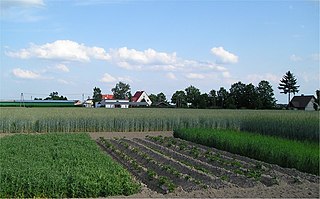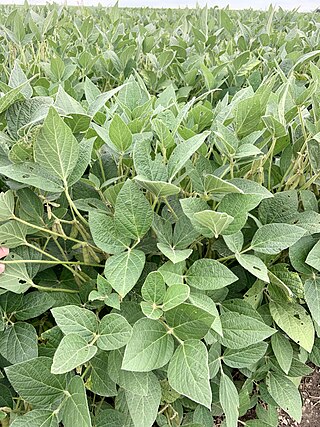Related Research Articles

Crop rotation is the practice of growing a series of different types of crops in the same area across a sequence of growing seasons. This practice reduces the reliance of crops on one set of nutrients, pest and weed pressure, along with the probability of developing resistant pests and weeds.
The following outline is provided as an overview of and topical guide to sustainable agriculture:
Conservation agriculture (CA) can be defined by a statement given by the Food and Agriculture Organization of the United Nations as "Conservation Agriculture (CA) is a farming system that can prevent losses of arable land while regenerating degraded lands.It promotes minimum soil disturbance, maintenance of a permanent soil cover, and diversification of plant species. It enhances biodiversity and natural biological processes above and below the ground surface, which contribute to increased water and nutrient use efficiency and to improved and sustained crop production."

In agriculture and horticulture, a beetle bank is a form of biological pest control. It is a strip, preferably raised, planted with grasses and/or perennial plants, within a crop field or a garden, that fosters and provides habitat for beneficial insects, birds, and other fauna that prey on pests.

In agriculture, polyculture is the practice of growing more than one crop species together in the same place at the same time, in contrast to monoculture, which had become the dominant approach in developed countries by 1950. Traditional examples include the intercropping of the Three Sisters, namely maize, beans, and squashes, by indigenous peoples of Central and North America, the rice-fish systems of Asia, and the complex mixed cropping systems of Nigeria.

Panicum virgatum, commonly known as switchgrass, is a perennial warm season bunchgrass native to North America, where it occurs naturally from 55°N latitude in Canada southwards into the United States and Mexico. Switchgrass is one of the dominant species of the central North American tallgrass prairie and can be found in remnant prairies, in native grass pastures, and naturalized along roadsides. It is used primarily for soil conservation, forage production, game cover, as an ornamental grass, in phytoremediation projects, fiber, electricity, heat production, for biosequestration of atmospheric carbon dioxide, and more recently as a biomass crop for the production of ethanol and butanol.

Soil conservation is the prevention of loss of the topmost layer of the soil from erosion or prevention of reduced fertility caused by over usage, acidification, salinization or other chemical soil contamination.

Strip cropping is a method of farming which involves cultivating a field partitioned into long, narrow strips which are alternated in a crop rotation system. It is used when a slope is too steep or when there is no alternative method of preventing soil erosion. The most common crop choices for strip cropping are closely sown crops such as hay, wheat, or other forages which are alternated with strips of row crops, such as corn, soybeans, cotton, or sugar beets. The forages serve primarily as cover crops. In certain systems, strips in particularly-eroded areas are used to grow permanent protective vegetation, but in most systems, all strips are alternated on an annual basis.

In agriculture, a living mulch is a cover crop interplanted or undersown with a main crop, and intended to serve the purposes of a mulch, such as weed suppression and regulation of soil temperature. Living mulches grow for a long time with the main crops, whereas cover crops are incorporated into the soil or killed with herbicides.

Prairie restoration is a conservation effort to restore prairie lands that were destroyed due to industrial, agricultural, commercial, or residential development. The primary aim is to return areas and ecosystems to their previous state before their depletion.

The Conservation Reserve Program (CRP) is a cost-share and rental payment program of the United States Department of Agriculture (USDA). Under the program, the government pays farmers to take certain agriculturally used croplands out of production and convert them to vegetative cover, such as cultivated or native bunchgrasses and grasslands, wildlife and pollinators food and shelter plantings, windbreak and shade trees, filter and buffer strips, grassed waterways, and riparian buffers. The purpose of the program is to reduce land erosion, improve water quality and effect wildlife benefits.
Intensive crop farming is a modern industrialized form of crop farming. Intensive crop farming's methods include innovation in agricultural machinery, farming methods, genetic engineering technology, techniques for achieving economies of scale in production, the creation of new markets for consumption, patent protection of genetic information, and global trade. These methods are widespread in developed nations.

A buffer strip is an area of land maintained in permanent vegetation that helps to control air quality, soil quality, and water quality, along with other environmental problems, dealing primarily on land that is used in agriculture. Buffer strips trap sediment, and enhance filtration of nutrients and pesticides by slowing down surface runoff that could enter the local surface waters. The root systems of the planted vegetation in these buffers hold soil particles together which alleviate the soil of wind erosion and stabilize stream banks providing protection against substantial erosion and landslides. Farmers can also use buffer strips to square up existing crop fields to provide safety for equipment while also farming more efficiently.

Conservation grazing or targeted grazing is the use of semi-feral or domesticated grazing livestock to maintain and increase the biodiversity of natural or semi-natural grasslands, heathlands, wood pasture, wetlands and many other habitats. Conservation grazing is generally less intensive than practices such as prescribed burning, but still needs to be managed to ensure that overgrazing does not occur. The practice has proven to be beneficial in moderation in restoring and maintaining grassland and heathland ecosystems. Conservation or monitored grazing has been implemented into regenerative agriculture programs to restore soil and overall ecosystem health of current working landscapes. The optimal level of grazing and grazing animal will depend on the goal of conservation. Different levels of grazing, alongside other conservation practices, can be used to induce desired results.

A riparian buffer or stream buffer is a vegetated area near a stream, usually forested, which helps shade and partially protect the stream from the impact of adjacent land uses. It plays a key role in increasing water quality in associated streams, rivers, and lakes, thus providing environmental benefits. With the decline of many aquatic ecosystems due to agriculture, riparian buffers have become a very common conservation practice aimed at increasing water quality and reducing pollution.

Soybean management practices in farming are the decisions a producer must make in order to raise a soybean crop. The type of tillage, plant population, row spacing, and planting date are four major management decisions that soybean farmers must consider. How individual producers choose to handle each management application depends on their own farming circumstances.
The effect of organic farming has been a subject of interest for researchers. Theory suggests that organic farming practices, which exclude the use of most synthetic pesticides and fertilizers, may be beneficial for biodiversity. This is generally shown to be true for soils scaled to the area of cultivated land, where species abundance is, on average, 30% richer than that of conventional farms. However, for crop yield-scaled land the effect of organic farming on biodiversity is highly debated due to the significantly lower yields compared to conventional farms.
Indigenous horticulture is practised in various ways across all inhabited continents. Indigenous refers to the native peoples of a given area and horticulture is the practice of small-scale intercropping.

Carbon farming is a set of agricultural methods that aim to store carbon in the soil, crop roots, wood and leaves. The technical term for this is carbon sequestration. The overall goal of carbon farming is to create a net loss of carbon from the atmosphere. This is done by increasing the rate at which carbon is sequestered into soil and plant material. One option is to increase the soil's organic matter content. This can also aid plant growth, improve soil water retention capacity and reduce fertilizer use. Sustainable forest management is another tool that is used in carbon farming. Carbon farming is one component of climate-smart agriculture. It is also one way to remove carbon dioxide from the atmosphere.

A wildflower strip is a section of land set aside to grow wildflowers. These can be at the edge of a field to mitigate against agricultural intensification and monoculture; along road medians and verges; or in parkland or other open spaces such as the Coronation Meadows. Such strips provide an attractive amenity and can also improve biodiversity, conserving birds, insects and other wildlife.
References
- ↑ Charles, Dan (14 July 2020). "How Absentee Landowners Keep Farmers From Protecting Water and Soil". NPR. Retrieved 14 July 2020.
- ↑ Kemmerling, Lindsey R.; Rutkoski, Corinn E.; Evans, Sarah E.; Helms, Jackson A.; Cordova-Ortiz, Esbeiry S.; Smith, Jamie D.; Vázquez Custodio, Jorge A.; Vizza, Carmella; Haddad, Nick M. (10 May 2022). "Prairie Strips and Lower Land Use Intensity Increase Biodiversity and Ecosystem Services". Frontiers in Ecology and Evolution. 10. doi: 10.3389/fevo.2022.833170 . ISSN 2296-701X.
- ↑ "Prairie Strips". Iowa State University of Science and Technology. Retrieved 14 July 2020.
- ↑ Beacom, Nathan (15 October 2019). "Planting Native Prairie Could Be a Secret Weapon for Farmers". Civil Eats. Retrieved 25 October 2021.
- ↑ Sampson, Fred; Knopf, Fritz (1 June 1994). "Prairie conservation in North America". Other Publications in Wildlife Management.
- ↑ Oldfield, Sara F. (25 September 2019). Seeds of Restoration Success: Wild Lands and Plant Diversity in the U.S. Springer. ISBN 9783319969749.
- ↑ "Conservation Buffers: Case Study: Buffer Strips for Soybean Aphid Control". Farming with Native Beneficial Insects: Ecological Pest Control Solutions. The Xerces Society. 25 September 2019. ISBN 978-1-61212-284-7.